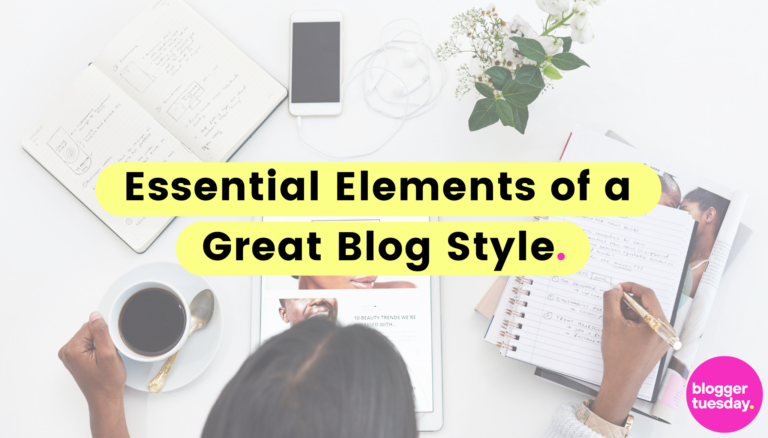Uncover the essential elements of a compelling blog style, from knowing your audience to maintaining consistency, adding a personal touch, and more.
Maintaining a successful blog requires you to think of a lot of different things at once, and it is a process that rewards persistence. Even after it goes live, you’re probably going to be making a lot of changes, from small necessary tweaks to larger overhauls, as you seek to find the identity that makes your blog successful. Of course content should be a major part of your efforts, but you’ll find that it’s a lot easier to write that content if you have a style within which to fit it. Putting together an overarching style to make your blog the best it can be is at the basis of all blogs that engage an audience in the long term.
So what are the elements that go into creating a great blog style? As you might expect, there aren’t just one or two things you have to get right. As you’ll see when you read on, crafting the ideal blog style means nailing down several sides of the process – but get these right, and you’ll be well on your way to having success with your personal or commercial blog.
1. Knowing Your Target Audience
Your blog style must be reflective of your target audience’s preferences. This involves not only the content itself but also other elements like the visual aesthetics, navigation, and user interface. For instance, if your blog caters to the academic community, your color scheme and font might be more restrained, and your post lengths longer with deep dive content. Conversely, a celebrity gossip blog might use more vibrant colors and have shorter, snappier posts.
2. Language and Tone
The language and tone of your blog are also paramount in attracting and maintaining your audience. In general, blog language should be accessible and conversational. Strictly formal language might be off-putting to many readers unless your target audience prefers a formal tone (e.g., scientific or legal blogs). However, the principle remains the same: your language should reflect your readers’ preferences.
3. Consistency
Consistency is key in blog style. Whether it’s your visual theme, voice, or posting schedule, maintaining consistency helps to establish your brand identity and builds trust with your audience. Readers appreciate knowing what to expect and can feel disoriented if the style varies too much. Indeed, it will be off-putting and may turn regular readers away if you suddenly change from an informative, authoritative tone to a cheery, slang-laden way of writing. Once you’ve established a style that you’re happy with and your readers respond to, keep that going.
4. Personal Touch
People connect with people, not machines. Giving your blog a personal touch can make it more relatable and engaging. This could be sharing personal stories or experiences, using a unique writing style, or infusing your posts with your personality and humor. It’s up to you how much of your life you let people in on, though. Your family, friends and pets do not need to become a supporting cast (although pets are always going to gain plenty of admiring attention on the internet). You can be more than sufficiently warm and welcoming on your blog without giving away too much identifying detail – and if you’ve honed your own style of writing, that will be more than ample to gain the attention of your audience.
5. Visual Appeal
Blog posts with attractive and relevant visuals receive 94% more views than those without. This includes images, infographics, videos, or even embedded tweets or Instagram posts. Never miss a chance to include something visual to break the post up a little. A wall of text can be intimidating, and images are an excellent way to stick to the maxim “show, don’t tell”, which has become a go-to mantra for people who make their living by blogging or vlogging. Ensure your visuals match your content and aesthetic, and always give proper attribution. This is important from a legal standpoint, but it’s also just the right thing to do.
6. Readability
Any good blog style involves structuring your posts in a way that is easy to read. This can involve using headings and subheadings, bullet points, short paragraphs, and including a clear call to action. Also, pay attention to font size and type to ensure it’s comfortable for extended reading. It doesn’t happen so much nowadays, but those of us who were there for Blog 1.0 remember all too well the nightmare of reading blogs written in purple Comic Sans on a black background. We know better in the 2020s, so no matter what your blog is about, make sure that it’s comfortable to read as well as being informative.
7. Relevance
Relevance in the world of blogging holds a two-fold significance, pertaining to both visual and content aspects of your blog. On the visual front, maintaining a blog style that aligns with current design trends, while still keeping true to your brand identity, is essential. Stale or outdated design elements can lead readers to perceive your content as being irrelevant or out-of-touch. Similarly, the imagery and graphics you use should reflect the subject matter and tone of your blog.
But relevance goes beyond just aesthetics. It touches deeply on the very content you present to your readers. The digital world is fast-paced, with trends emerging and news breaking every second. As a blogger, staying relevant means keeping abreast of these developments, particularly those within your niche. For example, if a major news story breaks that’s related to your area of expertise, it’s crucial that you provide your unique insights on the matter. These timely posts not only boost your credibility but also drive higher engagement rates. By staying relevant, you show your audience that you’re not just an observer but an active participant in the discourse of your niche.
8. SEO Optimization
While the main focus should always be the reader, incorporating SEO strategies into your blog style can help attract more visitors. This includes proper use of keywords, meta descriptions, URL structures, and interlinking your posts. This can be achieved naturally if you’re comfortable with writing for SEO. Opportunities will always present themselves to link back to old or recent posts, and if you’re writing on a topic that has any meaning you should see keywords popping up even without intending to include them. In any case, don’t let SEO dictate your style – the best content is written for humans first and search engines second.
9. User Interaction
A great blog style encourages interaction. This could be through the use of comments, social media sharing buttons, or inviting guest posts. The more your readers can interact with your blog, the more engaged they will be. How you write your blog posts will influence how much interaction it gets. Including little gobbets of language at the end of your posts, such as “What do you think? Tell me in the comments!” or even, after a post on a controversial topic, “This will probably ruffle a few feathers – let me know how wrong I am below the line!”. Meanwhile, on a post you feel is important, you might start the content with “This is something I feel very strongly about; if it matters to you too, please share”.
Inviting guest posts isn’t a difficult thing to do – people will always want to share their own opinions and insights to a wider audience, and it is a good way of building relationships with your audience – if some of your readers are blog owners themselves, this is even an “in” to potentially exchanging guest posts where you can post on their blog and open your own up to a wider audience. It is also a way of generating backlinks to your site, which is great for SEO. Include a page on your blog where you specifically invite guest posts, with a contact form allowing the reader to introduce themselves and tell you a little about what they want to post.
10. Innovation
Finally, don’t be afraid to be innovative. Blogging is a dynamic field, and new trends and tools are constantly emerging. While it’s important to maintain some consistency, regular refreshes of your blog’s look and feel can keep your content fresh and exciting. This can happen fairly naturally. As your blog gets more eyes on it, you’ll start to think about how people are seeing it and you may want it to look more professional. This can mean a tidier banner along the top of the blog, pulling featured posts to show first when people visit, and an overhaul of the font and format used.
You can also adapt to the prevailing styles that you see from influential blogs in your niche. Blogging, like any online endeavour, is very much prone to changes in style and dynamic adaptation. What worked in 2021 might not work in 2023, not because it is any less technically sound, but because of changes in trend. If you are a blogger, you should be reading other blogs anyway, but it’s all the more beneficial when you want to make sure your own content and the style of your blog are keeping pace with what’s out there.
Remember, your blog style should ultimately reflect your unique voice and appeal to your target audience. Each element you choose should be deliberately and thoughtfully designed to create an engaging and rewarding experience for your readers.


